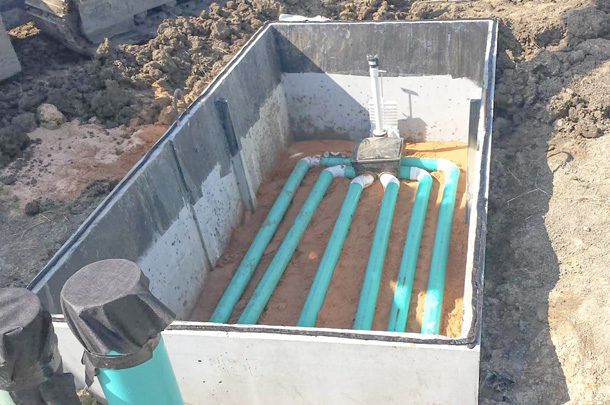The relationship between farmers and phosphorus is a complicated one. While farmers need phosphorus to ensure optimal plant growth, health and yield, small amounts can escape and cause significant problems in water quality. This complex balance is what Dr. Chad Penn calls the “phosphorus paradox.”
Penn, a soil scientist at the Agricultural Research Service (ARS) National Soil Erosion Unit, began researching phosphorus removal systems in 2005. Early in his research, he discovered treating soil and manure for phosphorus was short-lived. This sparked his interest in creating a phosphorus removal system to treat field runoff and drainage water instead.
The main target of a phosphorus removal system is to reduce dissolved phosphorus, or phosphorus that is already bound to the soils, and to minimize erosion. Dissolved phosphorus is more of a threat to water quality than particulate or sediment-bound forms, which is why these systems are intended to capture this specific form of phosphorus. If you can decrease pollution, then you can decrease particulate phosphorus, Penn says.
Figuring out if implementing a system is right for you can be challenging. Fortunately, a unique aspect of phosphorus removal systems is the many different design styles. You can determine which style is best for your farm by using a newly formulated technology, which outlines each step of the process to make things easier for the farmer, Penn says. The software, titled “P-Trap,” was designed by the scientists of ARS and is programmed to create a custom design specific to the characteristics of your farm.
“The idea is that you have a filter material that has an affinity for phosphorus,” Penn says. “If you characterize that material tested out, then you can use that information in a design.”
The software asks for information about the location of where the structure will be built, such as how much water flows from it, at what rate and the dissolved phosphorus concentration. Once this information is combined with your phosphorus reduction goals, P-Trap customizes a filter specific to your needs, Penn says.
With that inputted information, the software labels how many tons will be needed, the depth, length and width of the layer, and how many pipes will be used. The system also explains mass of media, orientation and drainage pipe requirements, Penn says.
The convenient factor of P-Trap is it is adaptable to farmers with different uses, Penn says.
“You can apply this system in whatever way you want, be it runoff in a field, buried beds for treating a tile drain – which is popular in the Midwest – treating wastewater, or urban and suburban areas,” Penn says.
Structurally, a phosphorus removal system must be in the right place. Ideally, a system should be built in areas with very high concentrations of phosphorus, such as barnyards. Penn says this is common with concentrated animal feeding operations (CAFO) because their feed is commonly imported from outside sources, which brings in more phosphorus than the farm can handle. Thus, the animals consume the feed, and once it passes through their manure, those nutrients are applied to the soil and never leave the farm.
In many cases, implementing a phosphorus trap can be free of expense to the farmer. The P-Trap software is free to use, and many state National Resource Conservation Service (NRCS) offices have a cost-share for phosphorus removal systems under their Environmental Quality Incentives Program (EQIP), Penn says.
Farmers interested in implementing a system are encouraged to contact the NRCS office in their conservation district and express their interest in installing a phosphorus removal structure under standard 782.
Because they are designed using gravity flow instead of pumps, maintenance is minimal once installed. The biggest maintenance factor is keeping sediment out of it, which can be done with relatively simple and reasonable practices, Penn says. On occasion, materials will need to be replaced, depending on the lifetime you choose in the beginning stages of design.
With this information at one’s fingertips, the challenge now stands in education and dissemination, Penn says. While farmers may recognize they have a phosphorus loss issue on their farm, the magnitude of that loss is often overlooked. The disconnect lies in farmers not recognizing how a small amount of phosphorus loss has a large environmental impact, says Dr. Joshua McGrath, a plant and soil science professor at the University of Kentucky.
“A very low nutrient loss, one pound of phosphorus per acre per year, is environmentally significant and agronomically insignificant and so it is external to the farm economics,” McGrath says.
Penn says this conservation practice is not one that will increase a farmer’s profitability or yield.
“The amount of phosphorus that we’re losing, is for the most part, inconsequential to the farmer,” Penn says. “It’s not like nitrogen, where it affects their pocketbook, crop or bottom line, but it does have a significant impact on water quality.”
McGrath works extensively with farmers to validate various P-Trap models and expresses the importance of having a farmer who is aware and educated. He says once farmers understand their environmental footprint, adoption is much easier.
With many eyes on production agriculturalists, a phosphorus removal structure provides the public with a visible representation of a farmer trying to be more sustainable, which is not possible with many conservation practices, Penn says.
This is where Steve Butler, an Oklahoma commercial broiler farmer, saw the greatest potential for the P-Trap. In 2015, Butler installed a P-Trap system because he was concerned his water runoff may have been polluting a nearby creek and to satisfy his own curiosity.
“We have people accuse us of so many things, that there’s not a science to back it up, so we want to actually provide the science and get it done,” Butler says.
While there may be no economic benefit, farmers can be confident their conservation efforts will be beneficial to their farm and leave them with a sense of good will, McGrath says.
“All farmers want is a system that works,” McGrath says. “We have to create systems that are responsive to the farmers' needs.”







